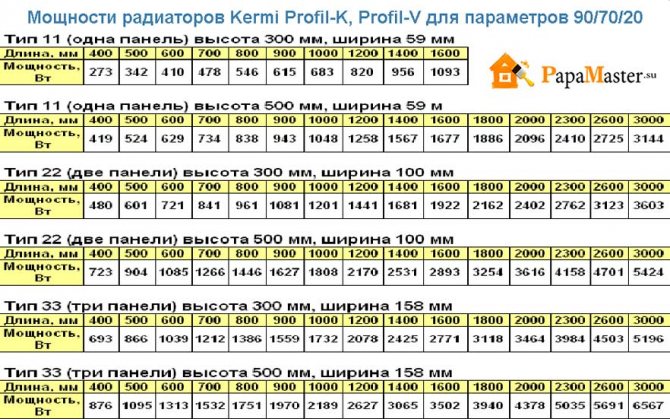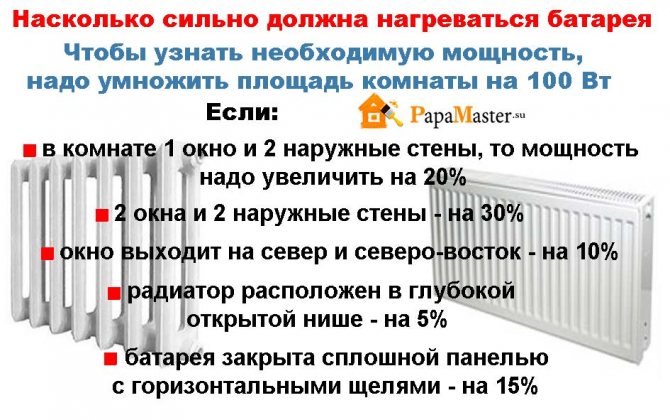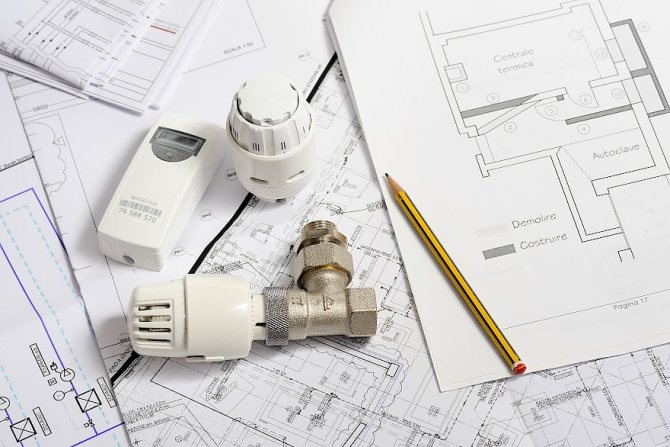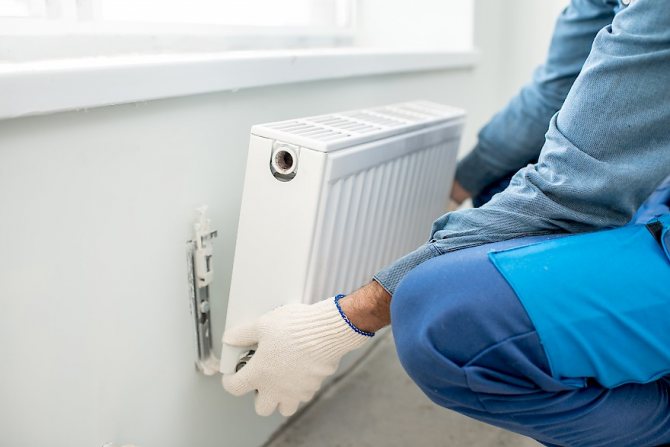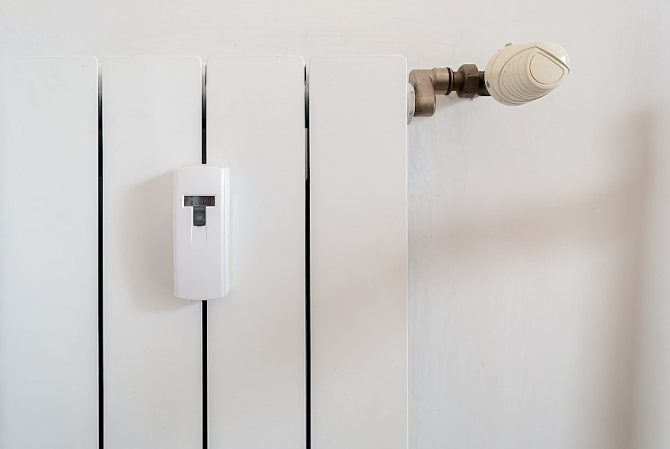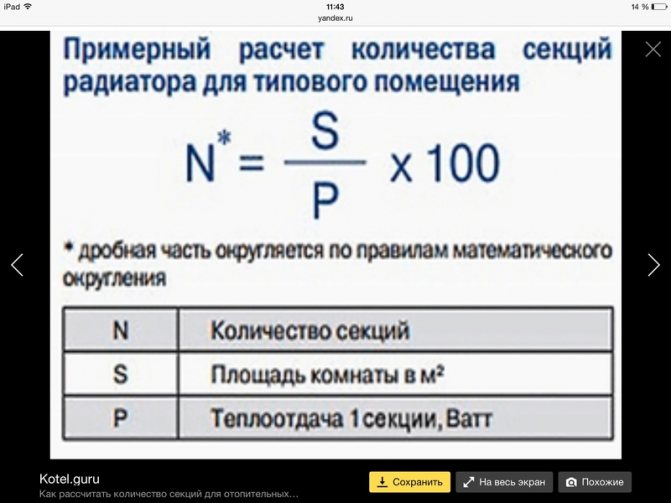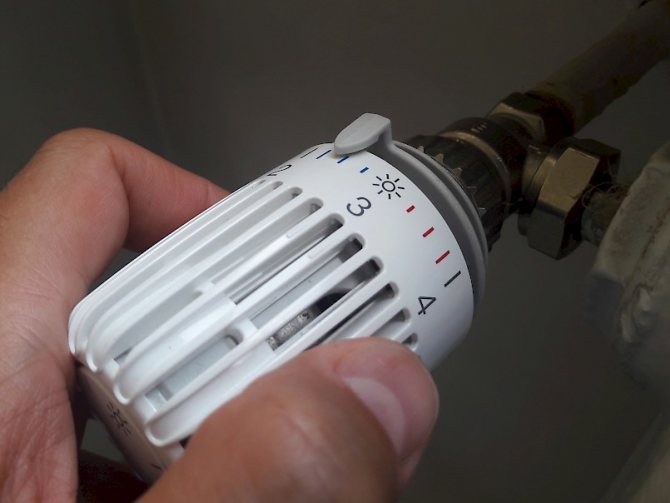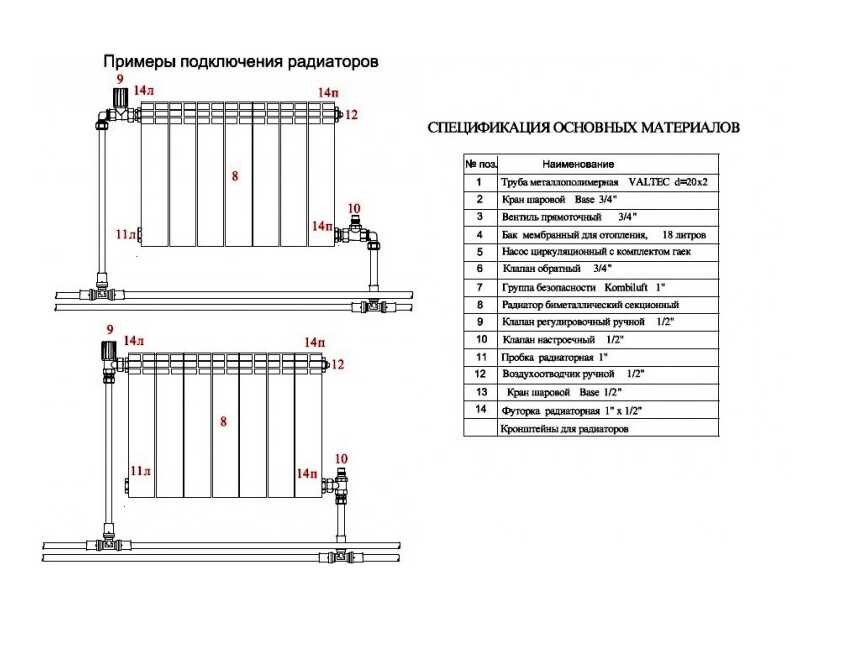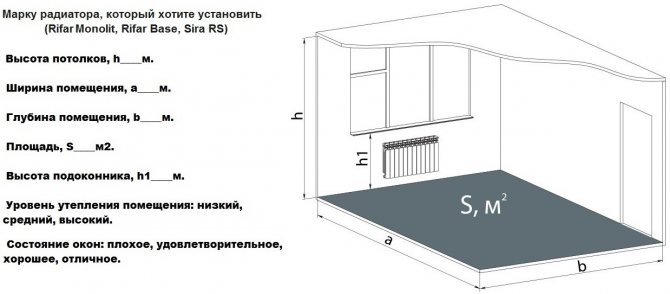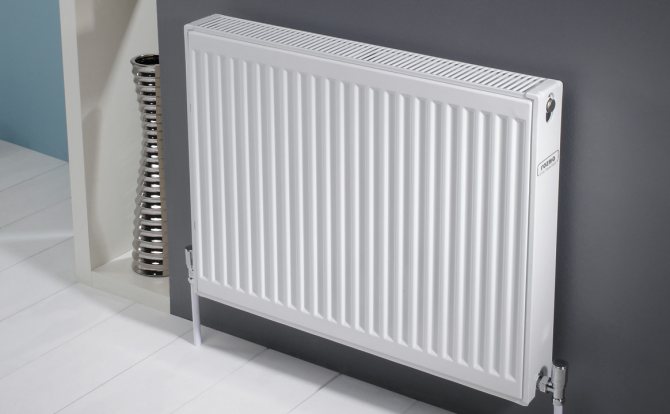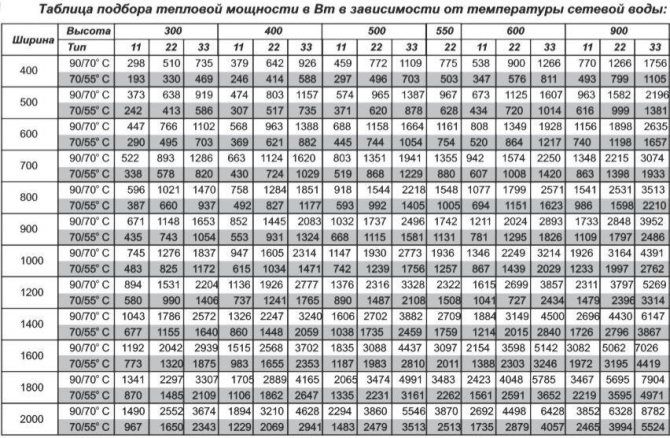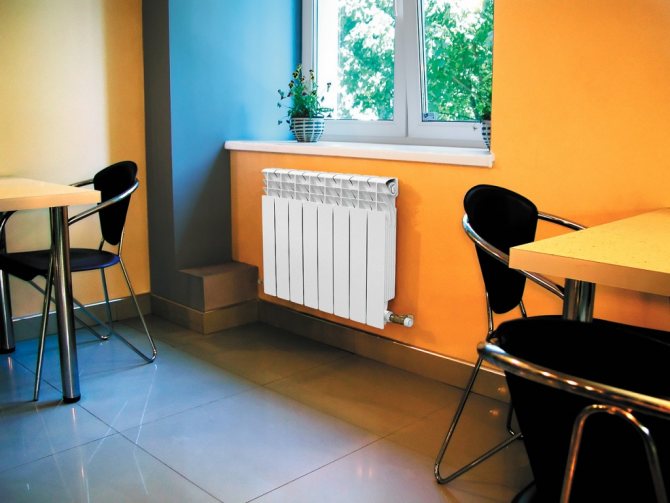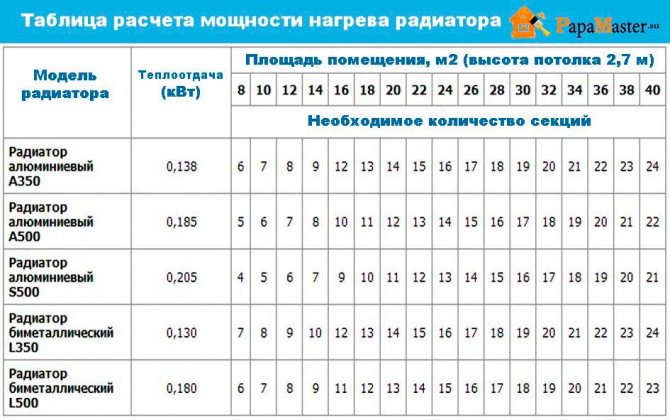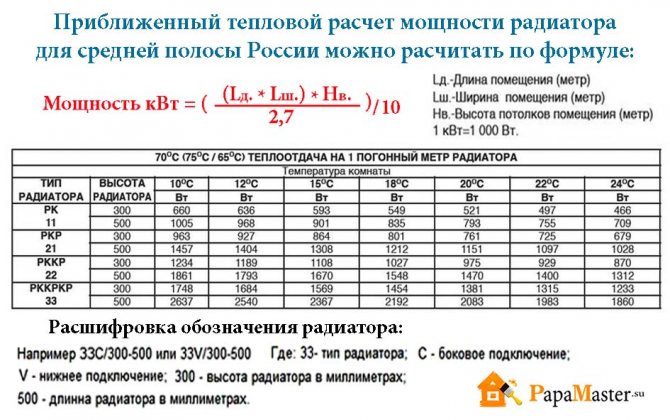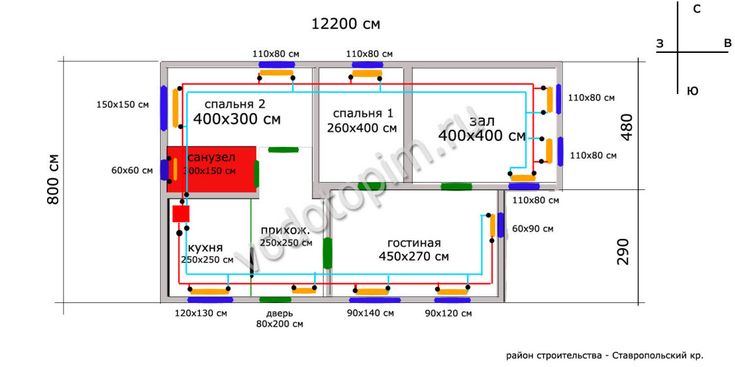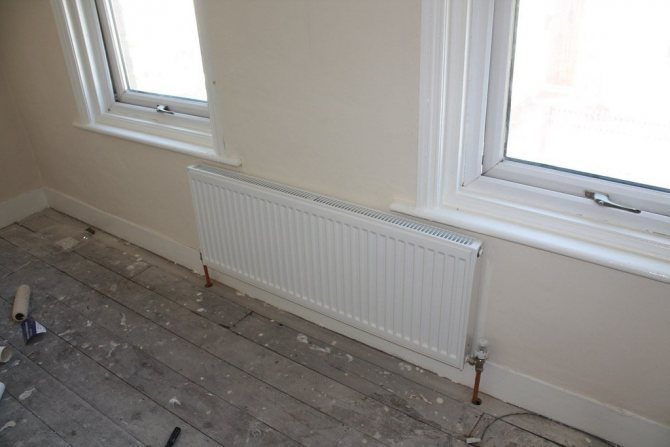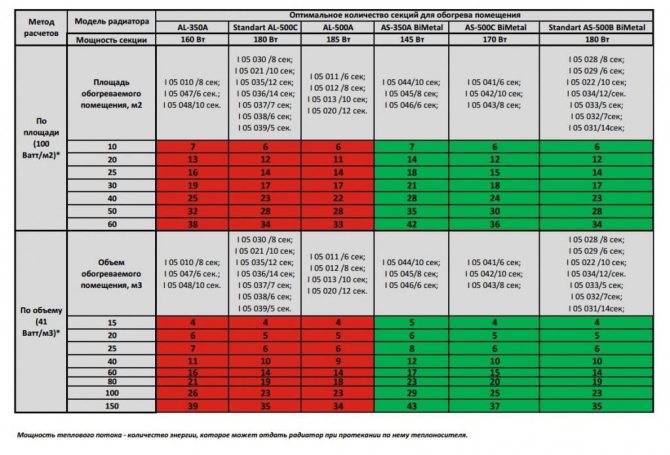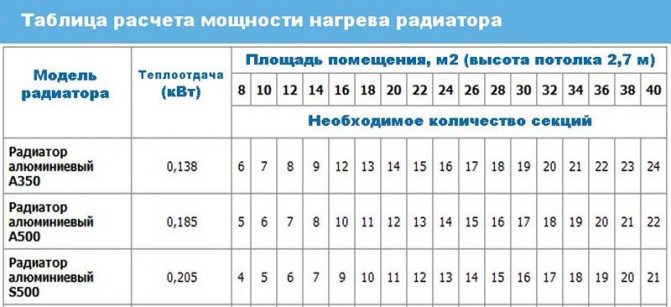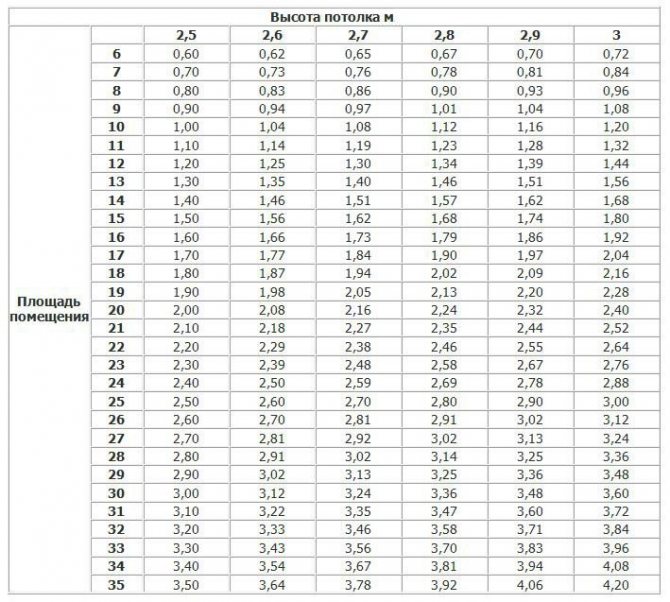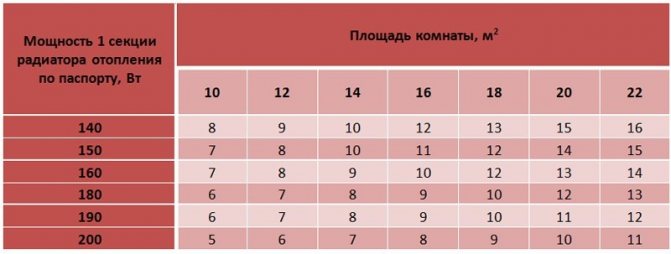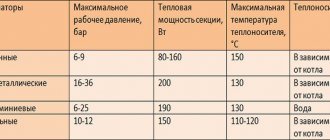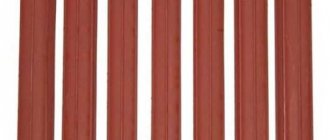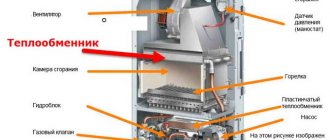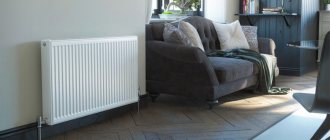Simple area calculations
You can calculate the size of the heating batteries for a certain room, focusing on its area. This is the easiest way - to use plumbing standards, which prescribe that a thermal power of 100 W per hour is needed to heat 1 sq. M. It must be remembered that this method is used for rooms with standard ceilings (2.5-2.7 meters), and the result is somewhat overestimated. In addition, it does not take into account such features as:
- the number of windows and the type of glass units on them;
- the number of external walls in the room;
- the thickness of the walls of the building and what material they are made of;
- the type and thickness of the insulation used;
- temperature range in a given climatic zone.
The heat that radiators must provide to heat the room: the area should be multiplied by the heat output (100 W). For example, for a room of 18 square meters, the following heating battery power is required:
18 m2 x 100 W = 1800 W
That is, 1.8 kW of power is needed per hour to heat 18 square meters. This result must be divided by the amount of heat that the heating radiator section emits per hour. If the data in his passport indicates that this is 170 W, then the next stage of calculations looks like this:
1800W / 170W = 10.59
This number must be rounded to the nearest whole (usually rounded up) - it will turn out to be 11. That is, in order for the room temperature to be optimal during the heating season, it is necessary to install a heating radiator with 11 sections.
This method is only suitable for calculating the size of the battery in rooms with central heating, where the temperature of the coolant is not higher than 70 degrees Celsius.
There is also a simpler method that can be used for the usual conditions of apartments in panel houses. This approximate calculation takes into account that one section is needed to heat 1.8 square meters of area. In other words, the area of the room should be divided by 1.8. For example, with an area of 25 square meters, 14 parts are needed:
25 m2 / 1.8 m2 = 13.89
But this calculation method is unacceptable for a radiator with reduced or increased power (when the average output of one section varies from 120 to 200 W).
Methods for calculating the number of radiator sections per square meter
To calculate the number of battery sections per 1 m2 of dwelling, one of the following methods is usually used:
- To find out how many battery sections are needed per square meter, you need to do some calculations. According to building codes, 100 watts of heating device power should fall on 1 m2 of a well-insulated house. Based on this, the corresponding calculations are carried out. For example, a 15 m2 room needs 1500 watts of radiator heat output. For cast-iron radiators, a parameter of 100 W is taken as a basis: as already indicated, it is almost impossible to achieve a maximum value of 180 W in practice. As a result, the optimal number of ribs is obtained - 15 pcs.
- Rooms with non-standard heights are more adequate to calculate in terms of volume. As an example, we can take the already familiar room with an area of 15 m2 and a height of 3 meters: its volume will be 45 m3. For one square meter, depending on the characteristics of the room, you need 30 - 40 watts. In a panel house, this indicator is taken as 40: a further simple calculation shows that 1800 W of thermal power is needed to effectively heat a room.
- Premises of complex configuration are calculated by formulas with a large number of coefficients.To avoid this rather cumbersome procedure, it is recommended to use the services of an online calculator. By entering the necessary data into special columns, you can get the desired result in a matter of seconds. In addition to convenience, this method will save you from errors in calculations, which are almost inevitable in case of independent implementation.
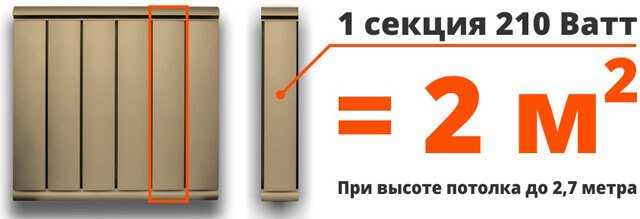
After the most convenient calculation method has been selected and the desired value is obtained, all the other factors mentioned above will also need to be taken into account. If they are available, it is necessary to increase the total number by the specified percentage of heat loss. As a result, they are fully compensated by an increase in the capacity of the heating system.
Consider a calculation method for rooms with high ceilings
However, the calculation of heating by area does not allow you to correctly determine the number of sections for rooms with ceilings above 3 meters. In this case, you must apply a formula that takes into account the volume of the room. To heat each cubic meter of volume, according to the SNIP recommendations, 41 W of heat is required. So, for a room with a ceiling height of 3 m and an area of 24 square meters, the calculation will be as follows:
24 square meters x 3 m = 72 cubic meters (room volume).
72 cubic meters x 41 W = 2952 W (battery power for heating the room).
Now you should find out the number of sections. If the radiator documentation indicates that the heat transfer of one part of it per hour is 180 W, the found battery power must be divided by this number:
2952 W / 180 W = 16.4
This number is rounded to the nearest whole - it turns out, 17 sections to heat a room with a volume of 72 cubic meters.
Using simple calculations, you can easily determine the data you need.
We count batteries by volume
There are norms in SNiP for heating one cubic meter of premises. They are given for different types of buildings:
- for brick for 1 m 3, 34 W of heat is required;
- for panel - 41 W
This calculation of radiator sections is similar to the previous one, only now we do not need an area, but the volume and norms are taken by others. The volume is multiplied by the norm, the resulting figure is divided by the power of one section of the radiator (aluminum, bimetallic or cast iron).


The formula for calculating the number of sections by volume
Sample calculation by volume
For example, let's calculate how many sections are needed in a room with an area of 16 m 2 and a ceiling height of 3 meters. The building is brick built. Let's take radiators of the same power: 140 W:
- Find the volume. 16 m 2 * 3 m = 48 m 3
- We consider the required amount of heat (the norm for brick buildings is 34 W). 48 m 3 * 34 W = 1632 W.
- Determine how many sections are needed. 1632W / 140W = 11.66 pcs. Round off, we get 12 pieces.
Now you know two ways to calculate the number of radiators per room.
Additional parameters to consider
Having made an approximate calculation of the number of heating radiator sections for your apartment, do not forget to correct it, taking into account the characteristics of the room. They need to be considered as follows:
- for a corner room (two walls facing the street) with one window, the radiator power must be increased by 20%, and with two windows - by 30%;
- if the radiator is mounted in a niche under the window, its heat transfer will decrease, this is compensated by an increase in power by 5%;
- should be increased by 10% if the windows face the north or north-east side;
- the screen, which covers the radiators for beauty, "steals" 15% of their heat transfer, which must also be taken into account when calculating.
At the very beginning, the total value of the required thermal power for the room should be calculated, taking into account all the available parameters and factors. And only then divide this value by the amount of heat that one section emits per hour. The result with a fractional value, as a rule, is rounded up to the nearest integer.
Calculation of different types of radiators
If you are going to install sectional radiators of a standard size (with an axial distance of 50 cm in height) and have already chosen the material, model and the required size, there should be no difficulty in calculating their number. Most reputable companies supplying good heating equipment have technical data for all modifications on their website, among which there is a thermal power. If not the power is indicated, but the flow rate of the coolant, then it is simple to translate into power: the flow rate of the coolant in 1l / min is approximately equal to the power of 1 kW (1000W).
The axial distance of the radiator is determined by the height between the centers of the holes for supplying / removing the coolant
To make life easier for buyers, a specially designed calculator program is installed on many sites. Then the calculation of heating radiator sections is reduced to entering data on your room in the appropriate fields. And at the output you have the finished result: the number of sections of this model in pieces.
The axial distance is determined between the centers of the holes for the coolant
But if you are just thinking about possible options, then it is worth considering that radiators of the same size from different materials have different thermal power. The method for calculating the number of sections of bimetallic radiators does not differ from the calculation of aluminum, steel or cast iron. Only the heat output of one section can be different.
To make it easier to read, there is averaged data by which you can navigate. For one section of a radiator with an axial distance of 50 cm, the following power values are adopted:
- aluminum - 190W
- bimetallic - 185W
- cast iron - 145W.
If you are just wondering which of the materials to choose, you can use this data. For clarity, we present the simplest calculation of sections of bimetallic heating radiators, which takes into account only the area of the room.
When determining the number of heating devices made of bimetal of standard size (center distance 50cm), it is assumed that one section can heat 1.8m 2 of area. Then for a room of 16m 2 you need: 16m 2 / 1.8m 2 = 8.88 pcs. Rounding up - 9 sections are needed.
We consider the same for cast iron or steel barriers. We only need norms:
- bimetallic radiator - 1.8m 2
- aluminum - 1.9-2.0m 2
- cast iron - 1.4-1.5m 2.
This data is for sections with a center distance of 50cm. Today, there are models on sale with very different heights: from 60cm to 20cm and even lower. Models 20cm and below are called curbs. Naturally, their capacity differs from the specified standard, and if you plan to use a "non-standard", you will have to make adjustments. Either look for passport data, or count yourself. We proceed from the fact that the heat transfer of a thermal device directly depends on its area. With decreasing height, the area of the device decreases, and, therefore, the power decreases proportionally. That is, you need to find the ratio of the heights of the selected radiator to the standard, and then use this coefficient to correct the result.
Calculation of cast iron heating radiators. Can count by area or volume of the room
For clarity, we will calculate the area of aluminum radiators. The room is the same: 16m 2. We count the number of sections of a standard size: 16m 2 / 2m 2 = 8pcs. But we want to use small sections with a height of 40cm. We find the ratio of radiators of the selected size to the standard ones: 50cm / 40cm = 1.25. And now we adjust the quantity: 8pcs * 1.25 = 10pcs.
Specificity and other features
It is also possible that there are other specificities for the premises for which the calculation is made, not all of them are similar and completely identical. These can be indicators such as:
- the temperature of the coolant is less than 70 degrees - the number of parts will have to be increased accordingly;
- the absence of a door in the opening between the two rooms. Then it is required to calculate the total area of both rooms in order to calculate the number of radiators for optimal heating;
- double-glazed windows installed on the windows prevent heat loss, therefore, fewer battery sections can be installed.
When replacing old cast iron batteries, which provided a normal temperature in the room, with new aluminum or bimetallic ones, the calculation is very simple. Multiply the heat dissipation of one cast iron section (150 W on average). Divide the result by the amount of heat of one new part.
Climatic zones are important too
It's no secret that in different climatic zones there is a different need for heating, therefore, when designing a project, these indicators must also be taken into account.
Climatic zones also have their own coefficients:
- the middle strip of Russia has a coefficient of 1.00, so it is not used;
- northern and eastern regions: 1.6;
- southern stripes: 0.7-0.9 (minimum and average annual temperatures in the region are taken into account).
This coefficient must be multiplied by the total thermal power, and the result obtained must be divided by the heat transfer of one part.
conclusions
Thus, the calculation of heating by area does not present any particular difficulties. It is enough to sit for a while, figure it out and calmly calculate. With its help, every owner of an apartment or house can easily determine the size of the radiator that should be installed in a room, kitchen, bathroom or anywhere else.
If you doubt your skills and knowledge, entrust the installation of the system to professionals. It is better to pay one time to the professionals than do it wrong, dismantle and re-start. Or do nothing at all.
Continuing the theme: high-quality interior doors www.dveri-tmk.ru will help keep warm in your house or apartment. And to simplify the calculations for the heating area.

